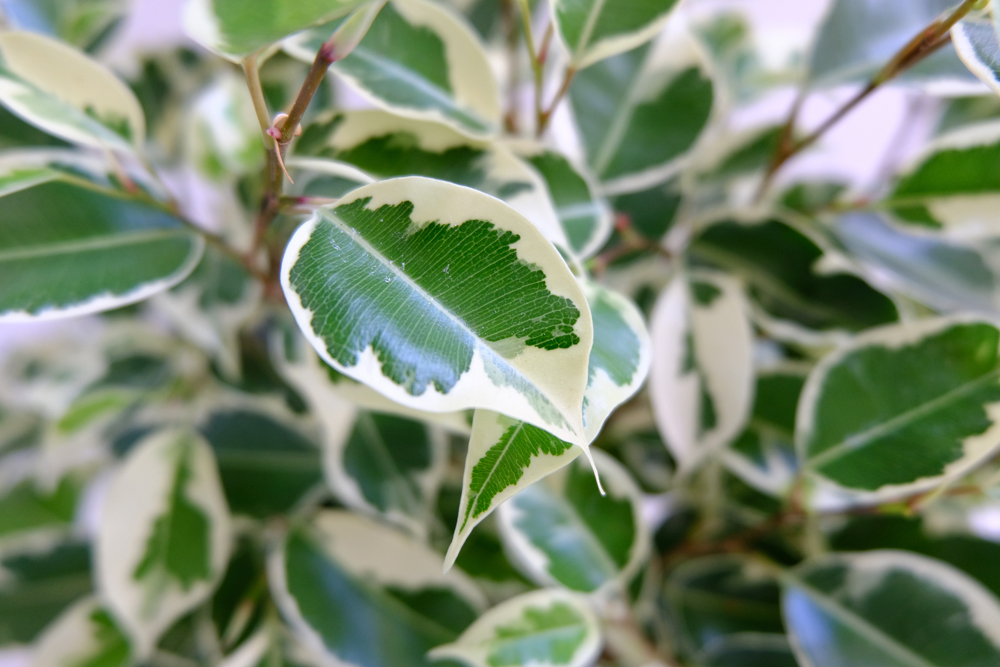Ficus neriifolia regularis (salicifolia)
Common Name:
Willow Leaf Fig

General Information:
Ficus salicifolia, also known as ficus neriifolia regularis, willow leaf fig, and narrow leaf fig, amongst others, is an evergreen tropical species of fig which originated in Indonesia. Its light to dark gray trunk thickens well and aerial roots develop from the trunk and branches in humid shady environments. The leaves are alternate, dark green, simple, lanceolate, one to three inches long and only a half inch to three quarters of an inch wide. New leaves are bronze to pinkish in color and usually curl to the right or to the left and straighten as they mature. Flowering and fruiting is insignificant.
Available from general purpose nurseries in South Florida and from bonsai nurseries throughout the country. It is easily propagated by cuttings of about any size taken in the summer. Specimens with large trunks can be potted into very shallow containers because all of the roots can be removed. Shortly after potting it will develop an entirely new set of roots.
Sudden changes in light or temperature may shock the ficus into shedding its leaves but new ones will develop shortly. During the interim, avoid over watering. Ficus salicifolia has been given many names over the years, however “Salicifolia” is he one which seems most universally accepted at present. But, by whatever name it is called, it is excellent material for nearly any style of bonsai.
Family:
Moraceae
Lighting:
The ficus will grow in deep shade to full sun. For best results in reducing the leaf and internode size, grow in full or nearly full sun.
Temperature:
The tree is not cold hardy and must be protected from frost and freezing weather.
Watering:
Water regularly and never let the soil dry out completely. Feeding: Feed frequently, but lightly, with a well balanced fertilizer year round.
Pruning and wiring:
Pruning and wiring can be done anytime and pinching must be constant throughout the year to maintain its shape. It tends to exhibit lateral branch dominance which means the side branches have to be kept in check to avoid weakening the central leader.
Propagation:
Cuttings.
Repotting:
Ficus salicifolia is best repotted in the warm weather. Its roots grow so rapidly that it may need repotting twice a year. It will grow in almost any soil, but prefers a porous, well drained, and slightly acid mixture.
Pests and diseases:
It is subject to spider mites, mealy bugs and various scale insects.
Some species suitable for bonsai:
Ficus altissima: lofty fig
Ficus aurea: Florida fig
Ficus benjamina: weeping fig, Benjamin tree
Ficus buxifolia
Ficus carica: common fig, fig tree
Ficus erecta: inu-biwa
Ficus macrophylla: Moreton Bay fig, Australian banyan
Ficus microcarpa: banyan
Ficus natalensis: Natal fig tree
Ficus neriifolia: fig, willow-leaf ficus
Ficus neriifolia regularis (also known as F. salicifolia): willow-leaf fig Ficus platypoda: Australian fig
Ficus pumila: creeping fig
Ficus religiosa: bo tree , peepful fig
Ficus retusa: fig, banyan fig, Indian laurel
Ficus retusa formosanum
Ficus rubiginosa: Port Jackson fig, rusty leaved fig
Ficus salicifolia (also known as F. neriifolia regularis): willow-leaf fig Ficus virens: spotted fig
Bibliography:
“Educational Forum”, by Marian Borchers and Lynn Liggett, Florida Bonsai, VII, 3:35-37.
“Ficus Neriifolia - also called Salicifolia”, by Mayna Hutchinson, Florida Bonsai, XIII, 4:3-9.
“Lucky 13th Convention Letter”, by Jim Smith, Florida Bonsai, XIV, 4:3-4. Also: FB X:2:24,XIII:3:4,XIV:3:21-3,XV:3:11-14,XVI:3:31- 34,XVII:4:9,XVIII:1:26,XX:4:12
Compiled by Thomas L. Zane
